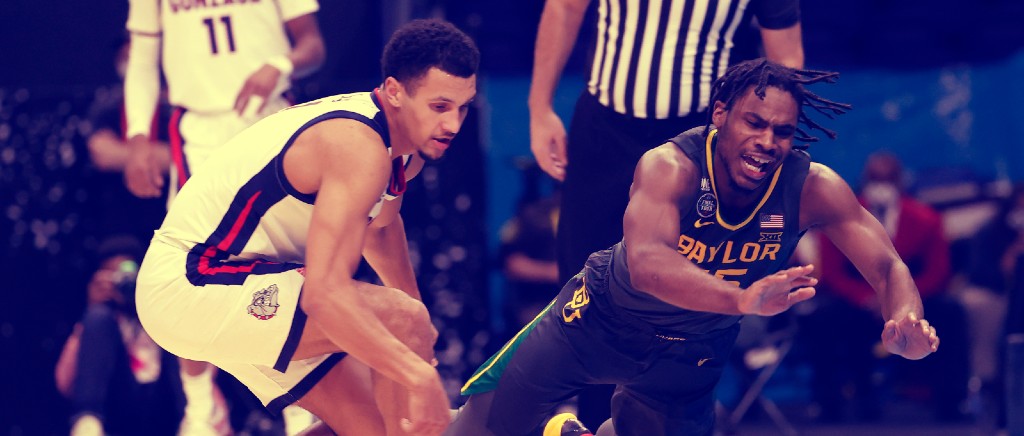The 2021 NBA Draft is more than three months away, but the majority of eligible prospects have taken part in their last competitive game before the big night. That coincides with the end of the 2021 NCAA Tournament, with Baylor bludgeoning Gonzaga on a Monday night in early April.
Many intriguing prospects took the floor in Indianapolis, headlined by Gonzaga’s Jalen Suggs appearing in six games, and as always, there were prospects that seemingly rose on draft boards over the course of the small sample of the NCAA Tournament. With that as the backdrop, it is time to check in with the first mock draft that includes the full season of college tape and statistics.
A lot can (and will) change as measurements, workouts and intel come to light in the coming days, but it’s time for draft season.
Note: Draft order determined by FiveThirtyEight projections as of Apr. 8.
1. Houston Rockets – Cade Cunningham (G/F, Oklahoma State)
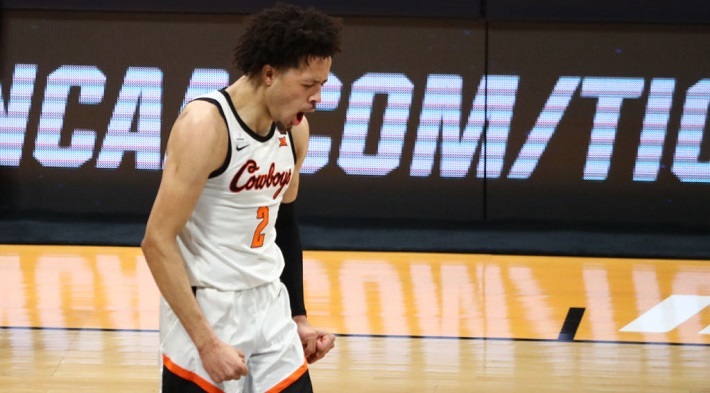
This remains an easy pick, and it would be hard for anything to change that at this stage. Honestly, Cunningham will be the recommended pick (at least for me) no matter which team wins the lottery, and he would be a heck of a prize for Houston as they kick-start a rebuilding process.
2. Minnesota Timberwolves – Jalen Suggs (G, Gonzaga)
Things become a lot less clear at No. 2 overall, and I could make a coherent argument for multiple players here. Candidly, I have Mobley at No. 2 on my board, but it is somewhat difficult to see the Wolves taking a center-first prospect to pair with Karl-Anthony Towns. Minnesota is highly invested in D’Angelo Russell but, simply put, that shouldn’t be enough to scare them off Jalen Suggs, who happens to be from the state.
3. Detroit Pistons – Evan Mobley (C, USC)
Detroit is a big winner here with my No. 2 prospect. There are concerns on whether Mobley has the instincts to be consistently aggressive offensively, and that might be the swing point in his ultimate projection. He’s a monster defensively, though, and his total package of skills is incredibly enticing.
4. Orlando Magic – Jalen Green (G, G League Ignite)
The Magic are fully pivoting to the future, and Green has the potential to be a No. 1 scorer in the NBA. The questions with Green come from what else he can do at a high level, but Orlando doesn’t have an offensive centerpiece on their roster, and swinging on a potential star is the move here.
5. Cleveland Cavaliers – Jonathan Kuminga (F/G, G League Ignite)
Kuminga isn’t a flawless fit with the Cavs, particularly after Cleveland invested in a shooting-challenged player (Isaac Okoro) in last year’s lottery. Still, he is very clearly the best prospect available and, if Kuminga figures out his jump shot, he could be a star. Even if he doesn’t, there are multiple paths to NBA success given his tools and motor.
6. Oklahoma City Thunder – Keon Johnson (G/F, Tennessee)
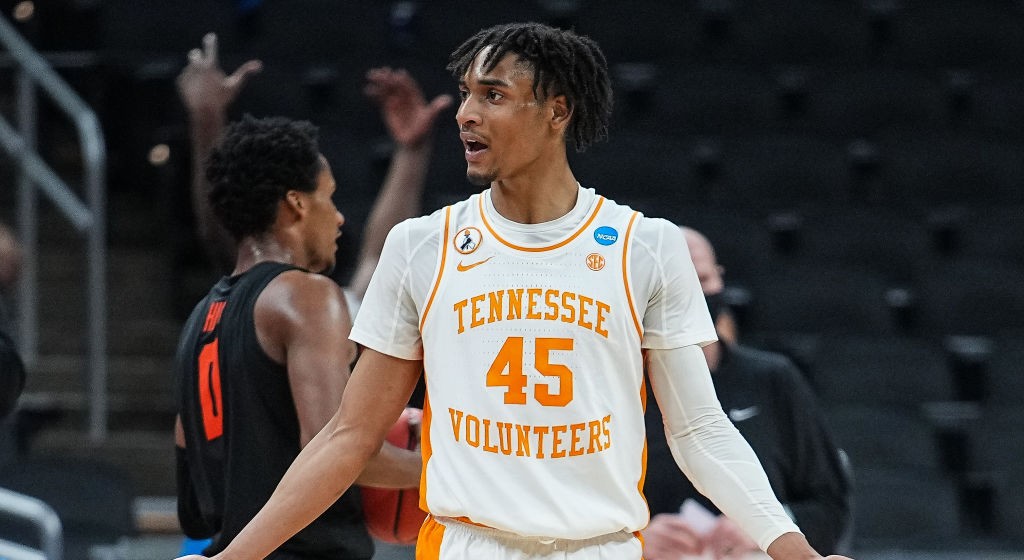
There is some uncertainty in the order of the top five, but that should be the top five. At No. 6… good luck. Johnson is a polarizing prospect, but he has tremendous tools, and seems to check all of the boxes that Oklahoma City historically looks for. Also, the Thunder have so many picks that they can lean into the upside a bit more than most teams.
7. Washington Wizards – Scottie Barnes (F, Florida State)
Barnes does have some real concerns, but he is a very impressive defender. The Wizards certainly could use an infusion of talent on that side of the floor, even with some potential overlap from drafting Rui Hachimura and Deni Avdija in back-to-back lotteries. He’s going to need to shoot to justify this level of investment, but there is a path to success even if he doesn’t, particularly if he can play center.
8. Orlando Magic (via Chicago) – Jalen Johnson (F, Duke)
After a roller coaster at Duke, Johnson is another player with no real consensus. On tools alone, he could be No. 6. If you want to be skeptical, he could fall into the late teens. However, he is 6’8 with play-making potential, and the Magic can take on some risk in exchange for upside.
9. Sacramento Kings – Kai Jones (C/F, Texas)
This is higher than I’m comfortable with for Jones, but he has a ton of helium right now. In addition, the Kings have Richaun Holmes hitting free agency and, with all due respect to Marvin Bagley, he doesn’t project as a long-term starting center. Jones may not be either, but his upside is really intriguing. He moves in a way that most players don’t at his size and, if you buy his defense, look out.
10. San Antonio Spurs – Franz Wagner (F, Michigan)
Wagner is one of a handful of potential lottery picks that had brutal showings in their final college sample. Candidly, he was dreadful against UCLA in an Elite 8 loss, and that probably scared people. If there is a concern with Wagner, it is a tendency to float offensively, and his jump shot has been inconsistent at times. In the NBA, though, he projects as more of a do-everything role player, and his defense is very intriguing. It would be unwise to overreact in the negative direction.
11. Toronto Raptors – Jaden Springer (G, Tennessee)

The Raptors picking this high is very interesting, and it may happen after the way they dug a hole this season. Springer is not a “Kyle Lowry replacement” because that isn’t fair to anyone, but he has sky-high potential in the backcourt and would be a theoretical fit with what the Raptors do. There is downside for sure, but at this point in the draft, that is almost a given.
12. New Orleans Pelicans – James Bouknight (G, UConn)
The Pelicans are very strange to project, particularly with Lonzo Ball dangling in free agency and an already unbalanced roster in some ways. However, this could also be sold as a “best player available” pick, as Bouknight is a ready-made shot creator that could become a long-term starting shooting guard if things break right.
13. New York Knicks – Davion Mitchell (G, Baylor)
This is higher than I have Mitchell on my personal board but, with the way people have been discussing him during Baylor’s title run, it may end up being lower than he actually goes, and this is a good time to remind everyone that mock drafts and big boards are different ventures. It’s easy to love Mitchell’s defense, and he can certainly initiate offense. From there, the pivot points are his age (turns 23 in September) and shooting. Mitchell was unconscious this season, hitting 44.7 percent of his threes, but he was a career 31 percent three-point shooter before 2020-21. He is also a career 66 percent free throw shooter, leaving some real questions about how sustainable his recent marksmanship actually is.
14. Golden State Warriors – Moses Moody (G/F, Arkansas)
In my view, this would be a heist for the Warriors. Like Franz Wagner, Moody put some poor play on tape in the NCAA Tournament, and that caused what I view to be an overreaction with his stock. For me, he’s a clear top-10 prospect in this draft, and his potential two-way impact is highly enticing as a high-end role player.
15. Indiana Pacers – Corey Kispert (G/F, Gonzaga)
It’s another player who struggled mightily on the big stage! There is no sugar-coating how overwhelmed Kispert looked in the title game against Baylor, and that likely will have an impact on his stock. On the other hand, it would be smart to take a step back and evaluate the whole picture, especially with what he’ll be asked to do in the NBA. The Joe Harris comparisons probably undersell just how good Joe Harris is, but if Kispert can hold up defensively at an adequate level, his shooting will do the rest.
16. Charlotte Hornets – Isaiah Jackson (C, Kentucky)
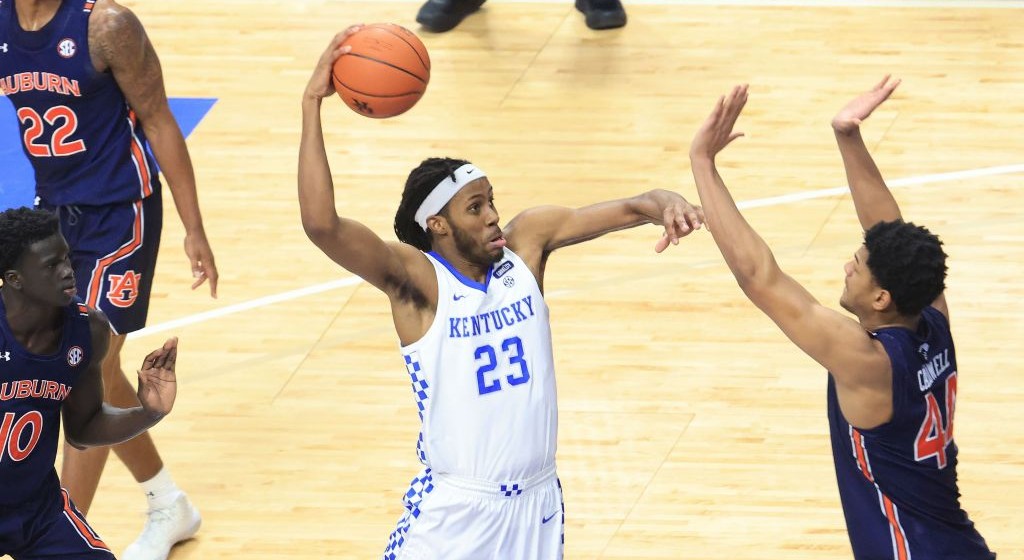
This is going to be a popular mock pick if Charlotte stays in this range. Jackson was a fast-rising prospect near the end of the season and, even with Kentucky not playing into late March, he’ll stay on the radar. He’s an intriguing athlete and the Hornets don’t have a player on their roster that can replicate his long-term skill set.
17. Memphis Grizzlies – Ziaire Williams (G/F, Stanford)
Williams’ stock is exceptionally difficult to pin down. Coming into the year, he was in the top-five mix for some, but he was not very good this season at Stanford. His tools are very, very interesting, though, and Williams could be a workout wonder. Memphis seems to capitalize on prospects that fall too far, and this could be another example.
18. Oklahoma City Thunder (via Miami) – Josh Giddey (G/F, Adelaide 36ers)
No team is in asset accumulation mode quite like the Thunder, and they could do just about anything. Giddey is a 6’8 playmaker that scouts are really enjoying in Australia, and there is always room for the skill set he has. OKC can also take it slow with him, which is probably for the best.
19. Boston Celtics – Day’Ron Sharpe (C, North Carolina)
I would probably go in a different direction here, but that isn’t because of Sharpe necessarily. He’s a center-only prospect and, while there is some intrigue with his ceiling, it’s not immense. Sharpe’s passing and athleticism are appealing, however, and the Celtics may want a long-term complement to Robert Williams. Many scouts seem to like Sharpe.
20. Atlanta Hawks – Tre Mann (G, Florida)
The Hawks are a bit of an odd team to pick for in that they don’t have major holes anywhere after a bunch of lottery picks and free agent additions. Still, Atlanta could certainly use another backcourt creator and Mann is rising quickly. He is reportedly 6’6 at this point, growing notably since arriving at Florida, and the Hawks could view him as a long-term sixth man type that can back up Trae Young while also playing with him.
21. Houston Rockets (via Portland) – Sharife Cooper (G, Auburn)
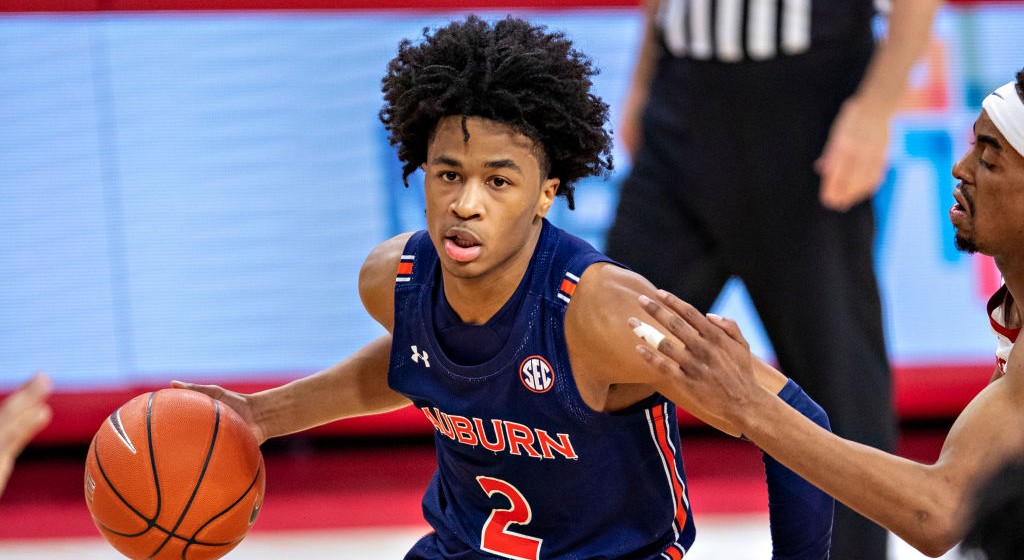
Evaluators are absolutely all over the place on Cooper but, by this point in the draft, most would probably agree the value is solid. He is an exceptional playmaker with elite passing and a strong handle. He’s also quite small, leading to pretty ugly defense on a regular basis, and Cooper’s perimeter shooting is a giant question mark. Houston is a good landing spot for him.
22. New York Knicks (via Dallas) – B.J. Boston (G/F, Kentucky)
The Kentucky Knicks! It didn’t go well at all for Boston this season with the Wildcats, but there is still some late first round buzz. He has real tools, as evidenced by his top-five preseason projection, and this is the point in the draft where it’s more than okay to invest. I’m joking about the Knicks and Kentucky… but I’m also not.
23. Los Angeles Lakers – Chris Duarte (G/F, Oregon)
Duarte is very old, and that will scare people. I get it. For a Lakers team that couldn’t be more in win-now mode, that doesn’t matter as much, and he is a legitimate 3-and-D weapon. It isn’t smart to overstate how much a rookie can help a contender but, if there is a player in this class that could be drafted in the 20’s and be playable right away, it’s probably Duarte.
24. Houston Rockets (via Milwaukee) – Greg Brown (F, Texas)
Continuing with the Rockets being in a position to take swings (see Cooper, Sharife), they snatch a hyper-athletic forward in Greg Brown. At one point, Brown was getting lottery buzz but, after a shaky season in Austin, that is largely gone. He does have the athletic package to return value here, and the slate is largely blank with the Rockets.
25. Denver Nuggets – Aaron Henry (G/F, Michigan State)
I’ve long been on the Aaron Henry train, and he started to turn the corner this season at Michigan State. In the NBA, he won’t need to take on the primary creation responsibilities he had under Tom Izzo, but his defense is legitimate and he fits well in a small offensive role. Denver could use another wing that doesn’t need the ball to be successful.
26. L.A. Clippers – Ayo Dosunmu (G, Illinois)
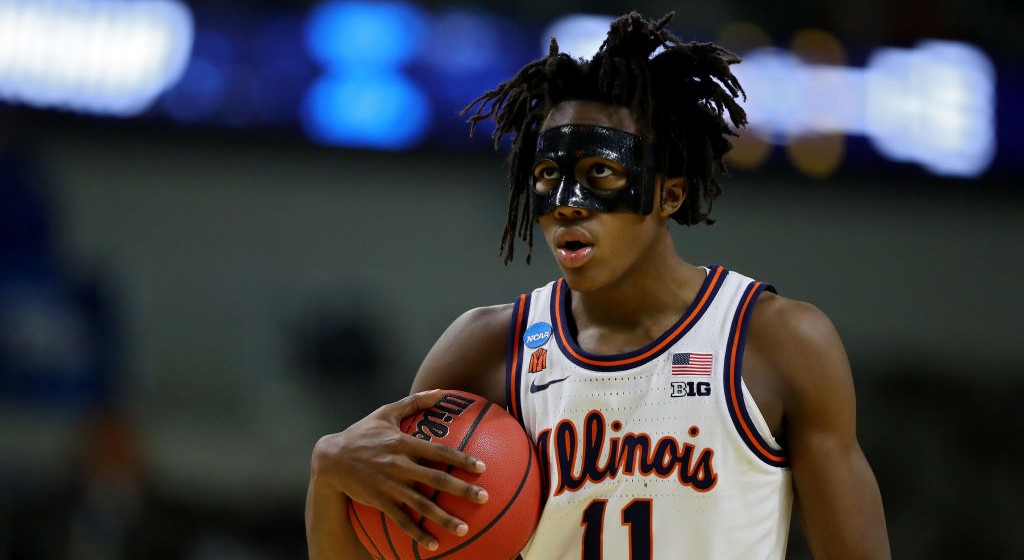
It was a bad ending for Dosunmu in the NCAA Tournament, but he was a tremendous player this season. He’s not an elite prospect by any stretch, but grabbing a potential third guard at this late stage of the draft is valuable. Dosunmu is also mature enough to potentially help a good team quickly, albeit in a small role.
27. Brooklyn Nets – Jeremiah Robinson-Earl (F, Villanova)
Some view Robinson-Earl as a second-round prospect, and this might be a touch high. Brooklyn is such a bizarre team that it is easy to justify this, because Robinson-Earl can (and will) defend at a high level and he doesn’t need the ball. He could also help to unlock some switchy lineups, which is helpful when you are building with James Harden on the team.
28. Philadelphia 76ers – Jared Butler (G, Baylor)
There is a lot to like about Jared Butler as a third guard type. The 76ers do have Tyrese Maxey already, but Butler is more in the George Hill mold long-term. Philadelphia just can’t have too many guards who can shoot and defend. Butler can do both.
29. Phoenix Suns – Bennedict Mathurin (G/F, Arizona)
This is a bit of a shot in the dark, and Mathurin may not even declare for the draft. He is fantastically interesting, though, and Suns owner Robert Sarver is famously an Arizona alum. Personally, I have Mathurin in my top 30, but scouts are admittedly split.
30. Utah Jazz – Alperen Sengun (C, Beskitas)
Sengun is a very strange evaluation. He’s been absolutely awesome overseas, and players his age aren’t usually as productive as he’s been. At the same time, he doesn’t project as a super-modern NBA big man. Scouts still seem to have him as a first-round talent, and the Jazz have fallen in love with backup centers in the past. More than anything, this would be a best player available selection, and Utah could look at Rokas Jokubaitis, Usman Garuba, Terrence Shannon or others in this slot.

